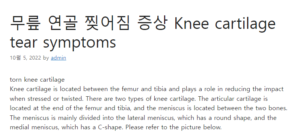torn knee cartilage
Knee cartilage is located between the femur and tibia and plays a role in reducing the impact when stressed or twisted. There are two types of knee cartilage. The articular cartilage is located at the end of the femur and tibia, and the meniscus is located between the two bones. The meniscus is mainly divided into the lateral meniscus, which has a round shape, and the medial meniscus, which has a C-shape. Please refer to the picture below.

knee joint structure
Knee cartilage supports our body, absorbs the impact of the knee joint, and allows the knee to move smoothly. Cartilage can be damaged if it is subjected to an unbearable shock during exercise or if it is worn over a long period of time.
Now, let’s take a closer look at the symptoms, causes, and treatment methods of knee cartilage tear. 무릎 연골 찢어짐 증상
Knee cartilage tear symptoms
Torn knee cartilage causes the following symptoms: 좋은뉴스
– Knee joint pain: The knee hurts even when you are resting without moving, and the pain worsens when you put on weight.
– Swelling of the knee: Swelling appears after a certain amount of time has passed since the injury occurred.
– Stiff knees
– Knocking or grinding sound when moving the joint
– Joints do not move well or move suddenly after being caught
Causes of knee cartilage tear
Knee cartilage can be torn when the knee joint is subjected to an unbearable impact during athletics. It may also be damaged when used repeatedly for a long time. Shocks received during exercise mainly cause meniscus damage.
Diagnosis of knee cartilage tear
If it is suspected that the knee cartilage is torn, the hospital makes a diagnosis through consultation, physical examination, and imaging tests. The McMurray test, in which the leg is moved from side to side, is done to check for damage to the meniscus. In addition to this, the diagnosis is made after determining the exact condition through X-ray or MRI examination.
Knee cartilage minor damage Home care
If you suspect damage to your knee cartilage, but your symptoms are mild and you can stand and walk, the following steps may help:
○ Protects the knee from further damage.
○ Rest as much as possible without moving your knees. When resting, use several pillows to keep your knees above your heart.
○ For the first 2-3 days, wrap ice in a towel and icing. Icing several times a day for 15-20 minutes.
○ Use a compression bandage to wrap the injured knee. It can limit movement and prevent swelling of the knee.
knee cartilage tear treatment
Knee cartilage tears are treated with:
◎ Medications: Nonsteroidal anti-inflammatory drugs (NSAIDs), such as aspirin, ibuprofen, and naproxen, can help relieve pain and swelling.
◎ Steroid injection: Depending on the condition, injecting a steroid into the damaged area can help relieve pain and reduce swelling.
surgical treatment
If the meniscus is torn or damaged and other treatments do not work, consider surgery. The most common method is to use knee arthroscopy. Make 2-3 small holes in the knee and insert a very small camera and surgical tools to correct the damaged area.
Knee joint endoscopic surgery
Partial meniscectomy is a surgical method that removes only the damaged area while maximizing the meniscus using a knee arthroscopy. Depending on the severity of the injury, you may be able to resume normal activities immediately after surgery.
Meniscus repair is a surgical procedure to suture torn knee cartilage with thread. This surgery also uses knee arthroscopy. It takes time for the sutured meniscus to reattach.
Rehabilitation is usually required to repair a knee cartilage tear. You should consult with your doctor for physical therapy and muscle strengthening exercises.
If you need a hospital visit
If you have minor damage, it may heal naturally. However, you should go to the hospital if:
– When it is difficult to move the joint
– When the pain is very severe
– When you can’t put your weight on your knees
– When the injured knee shows an abnormal shape
– When the knee is numb or the skin color changes or is cold
– When symptoms are not severe enough to self-medicate but do not recover after 2-3 days